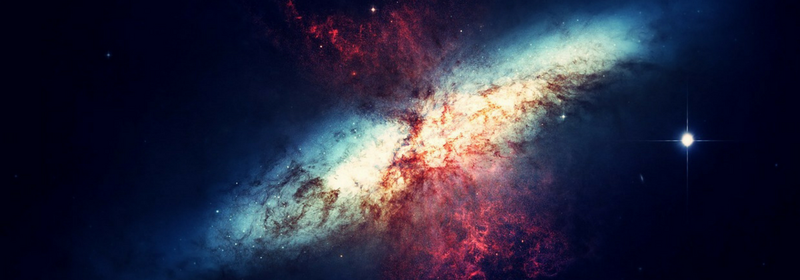
How to Make a Black Hole
Article Header
« Return to Main PageHow to Make a Black Hole
 A black hole is a place in space where the gravity is so strong that not even light can escape. But how can black holes form? What would make gravity so strong?
A black hole is a place in space where the gravity is so strong that not even light can escape. But how can black holes form? What would make gravity so strong?
To answer this question, we need to think about how gravity works. Gravity depends on two things—mass and distance. If you make something more massive, its gravity will get stronger. Or, if you get closer to something, its gravity will get stronger—in particular, if you cut the distance in half, the object’s pull will be four times as strong.[1]
There is a catch, though. When we say “distance,” we actually mean “distance to the center” of an object—and there’s a limit to how close you can get to the center of anything. Suppose you are trying to get close to the earth. Once you’re on the earth, you can’t get any closer—and you’ll still be 4000 miles away from the center. (Tunneling underground won’t help, because then part of the earth will be above you, pulling up.) That’s why the earth’s gravity is strongest at its surface.
 But what if we could squeeze the earth to make it smaller—and still keep its mass the same? Then we could get closer to the center. If we compressed the earth until its radius was only 2000 miles, we could get twice as close to the center, and the gravity would be four times as strong. If we could squeeze the earth down to 1000 miles, the gravity would be sixteen times as strong. And if—somehow—we could squeeze the whole earth down to the size of a marble, the gravity at the surface would be so strong that not even light could escape: the earth would be a black hole.
But what if we could squeeze the earth to make it smaller—and still keep its mass the same? Then we could get closer to the center. If we compressed the earth until its radius was only 2000 miles, we could get twice as close to the center, and the gravity would be four times as strong. If we could squeeze the earth down to 1000 miles, the gravity would be sixteen times as strong. And if—somehow—we could squeeze the whole earth down to the size of a marble, the gravity at the surface would be so strong that not even light could escape: the earth would be a black hole.
This “turning-into-a-black-hole radius” is called the Schwarzschild radius. Everything has a Schwarzschild radius—the Sun’s Schwarzschild radius is about 3 km, so if you could squeeze the sun down to that size, it too would become a black hole.
We don’t know of anything that could crush the earth so small—but stars are a different matter. Can anything squeeze a star this small? The star’s own gravity can—if the star is massive enough. (Remember that the more massive something is, the stronger its gravity is.) In fact, gravity is always trying to collapse stars—but for most stars, there’s enough light and heat coming out that this pressure balances the gravity. In short, the reason most stars don’t collapse is because they shine—so if stars stop shining, they collapse.
Stars can keep shining for a long time. The Sun has enough fuel to shine for billions of years—but after billions of years, the fuel would run out, gravity would take over, and the Sun would collapse.[2] It turns out that the Sun wouldn’t actually collapse all the way into a black hole—because after a while, the electrons in the Sun’s gas would build up enough pressure to stop the collapse—so the Sun would end its life as a white dwarf star. However, if a star has ten times the mass of the Sun, the electrons won’t be able to stop the collapse—it’s the neutrons that are able to stop it—so the star will end its life as a neutron star. But if the star has more than thirty times the mass of the Sun, its gravity will be so strong that when it collapses, nothing we know of can stop the process—and so the star will collapse into a black hole. As far as we know, this is how just about every black hole forms—a massive star collapses when it runs out of fuel.
But how do we know that black holes truly exist? Since no light escapes from inside, how can we ever see them? It turns out that we can detect a black hole if two stars are orbiting each other and one of them becomes a black hole while the other is still burning its fuel.
 We think something like this happened to a star named HDE 226868 in the constellation Cygnus. We can see that this star is orbiting something massive and invisible—something much too small to be a regular star. The only thing we know of that could be massive enough, small enough, and invisible enough is a black hole. We also can see that X-rays are coming from the area around this invisible object. (In fact, another name for this system is Cygnus X-1, because of these X-rays.) The X-rays come from gas which the black hole sucks off its companion star. The gas heats up as it falls into the black hole—and just before it disappears into the darkness, it gets hot enough to emit X-rays. So, we can “see” black holes by watching the effects of their gravity, both the effects on nearby stars and the effects on gas which the black holes vacuum up.
We think something like this happened to a star named HDE 226868 in the constellation Cygnus. We can see that this star is orbiting something massive and invisible—something much too small to be a regular star. The only thing we know of that could be massive enough, small enough, and invisible enough is a black hole. We also can see that X-rays are coming from the area around this invisible object. (In fact, another name for this system is Cygnus X-1, because of these X-rays.) The X-rays come from gas which the black hole sucks off its companion star. The gas heats up as it falls into the black hole—and just before it disappears into the darkness, it gets hot enough to emit X-rays. So, we can “see” black holes by watching the effects of their gravity, both the effects on nearby stars and the effects on gas which the black holes vacuum up.
Black holes are astonishingly powerful. If the earth got within a million miles of the black hole in Cygnus X-1, the black hole’s gravity on one side of the earth would be so much stronger than the pull on the other side, that the difference would tear the earth to pieces.We think something like this happened to a star named HDE 226868 in the constellation Cygnus. We can see that this star is orbiting something massive and invisible—something much too small to be a regular star. The only thing we know of that could be massive enough, small enough, and invisible enough is a black hole. We also can see that X-rays are coming from the area around this invisible object. (In fact, another name for this system is Cygnus X-1, because of these X-rays.) The X-rays come from gas which the black hole sucks off its companion star. The gas heats up as it falls into the black hole—and just before it disappears into the darkness, it gets hot enough to emit X-rays. So, we can “see” black holes by watching the effects of their gravity, both the effects on nearby stars and the effects on gas which the black holes vacuum up.But how do we know that black holes truly exist? Since no light escapes from inside, how can we ever see them? It turns out that we can detect a black hole if two stars are orbiting each other and one of them becomes a black hole while the other is still burning its fuel.
And yet God, through the laws of nature, makes black holes all the time—and this should impress us with how powerful the Lord Himself is. In Job 41, God describes the mighty animal Leviathan—and then He says (v. 10),
No one is fierce enough to rouse him [Leviathan].
Who then is able to stand against Me? (NIV)
In the same way, we stand in awe of the power of black holes. How much more, then, should we stand in awe of the power and the glory of their Creator?
P.S. On July 12, just days after this post was submitted, scientists finally confirmed something they had suspected for a long time—the active galactic nuclei powered by these supermassive black holes are the source of super-high energy cosmic ray particles. These particles have hundreds—or even thousands—of times more energy than anything the Large Hadron Collider can produce, and they travel billions of light years (from other galaxies) before finally getting to the earth. This is indeed God’s power displayed throughout the Universe. “Then sings my soul, my Savior, God, to Thee—how great Thou art!” —M.L.
[1] This relationship is called an inverse square law: it means that if you multiply your distance by a number, you divide the force by that same number squared. Thus, in the example above, when you multiply your distance by 1/2, you divide the force by (1/2)2—which is the same as multiplying by 4.
[2] Technically, the only part of the Sun that would collapse is the core—the outer layers would end up escaping and becoming a planetary nebula.









